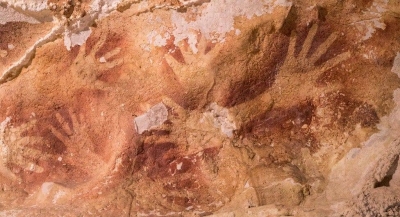
Have you ever dipped your hand into paint and created an imprint on a piece of paper or a wall? Isn’t it fun to see the impression your fingers and palms make on a surface?
Well, did you know that hand motifs have existed in art since prehistoric times? Or that the earliest prehistoric art could be handprints made by children? A team of archaeologists and paleontologists have discovered a series of handprints and footprints dating back to 169,000 B.C. and 226,000 B.C, making it possibly the oldest work of art ever known to humans.
Travertine treasure
The ancient prints were found on a boulder near the village of Quesang in Tibet, about 80 km northwest of the capital, Lhasa, beside a hot spring. Analysis suggests they were pressed into soft limestone called travertine that was deposited around the hot spring 169.000 to 226,000 years ago.
The size of the prints indicates they were made by two children, one about 7 years old and the other about 12.
What is parietal art?
The team of scientists, who made the discovery, argue that the prints are the earliest examples of parietal art. Parietal art is any prehistoric drawing, engraving or relief found on the surface of a rock or a cave. Parietal art is considered to be immobile (which cannot be moved).
The oldest parietal art is currently known from the Sulawesi region in Indonesia and the El Castillo caves in Spain, dating to 39.900 and 43,900 years ago. Both these sites have hand motifs.
Deliberate or not?
One of the chief questions on the minds of the researchers is whether the prints found on the Quesang plateau were deliberate or accidental? While most scientists agree that these prints were intentionally placed and so can be considered art, some remain sceptical about how they were made.
Did you know?
In July 2021, scientists announced the discovery of a carved deer bone in Hartz Mountains of Germany from 51,000 years ago that appears to be the oldest mobile work of art (which can be moved), which is the opposite of parietal art.
Picture Credit : Google




